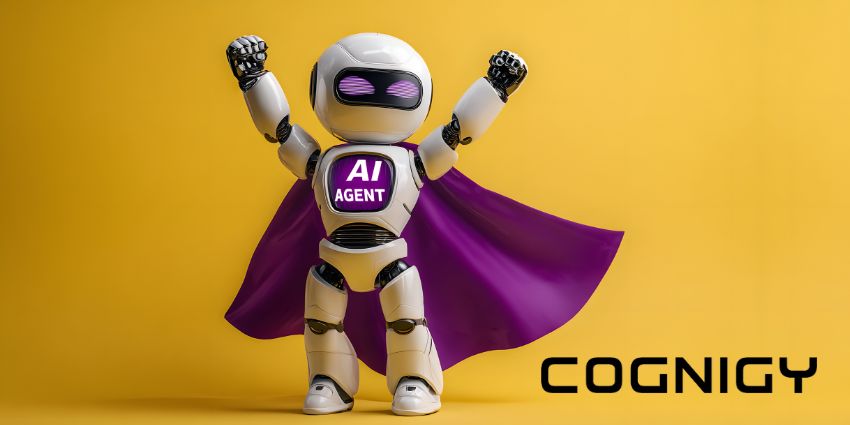Demand for chatbot technology is on the rise. For years now, consumers have been growing more accustomed to interacting with bots and virtual assistants when contacting businesses and contact centers. Although some of the earliest bots on the market were often clunky and overly simplistic, the rise of solutions like natural language processing and generative AI have helped to address this.
Today, the global chatbot market is projected to reach a value of $1.25 billion by 2025, and consumers are beginning to trust bots to deliver more efficient, convenient service. Used correctly, these powerful tools can allow companies to deliver 24/7 support to their customers, boost satisfaction scores, and improve workplace efficiency.
However, without the right strategy, business leaders could also end up building a chatbot that’s not only inefficient, but also a potential security risk for both customers, and the brand. So, how do organizations produce bots that are both secure, and intuitive?
Chatbots: The Security and Privacy Issues
Chatbots work best when they leverage huge amounts of data to deliver insightful responses to questions. Today’s most innovative bots and virtual assistants scan through billions of data points in seconds, capturing information not just from customers, but also from market databases, CRM systems, contact center tools and more. For instance, ChatGPT uses billions of pieces of data to transform unstructured information into human-like responses.
Unfortunately, while additional data can make bots a lot more reliable and productive, they also make them a serious security threat. The more data a bot processes, holds onto, and transmits, the riskier it becomes. Because of this, companies need to be particularly cautious about how information collected and managed by chatbots is stored.
What’s more, chatbots can also be subject to the same security gaps and vulnerabilities as countless other tools and technologies. Some of the most common vulnerabilities associated with bots include:
- Poor encryption: Lack of encryption when customers communicate with a chatbot, and when chatbots send data through to databases, can leave windows open for hackers.
- Insufficient training: Employees who don’t know how to work on or develop a chatbot correctly might accidentally leave the technology open to vulnerabilities.
- Data sovereignty: Companies using third-party tools for chatbot functionality don’t always know where the data from each conversation is stored, or how it’s protected.
- Hacking: Just as criminals can hack into a contact center phone system to collect sensitive information, they can also hack into the code of bots and virtual assistants.
- Data loss: Problems with the functionality of a bot could mean data ends up being lost, altered, or accidentally deleted, before it can be securely stored by a company.
As chatbots grow increasingly intuitive, consumers are growing more concerned about how these tools actually use their data. According to one study, only around 11% of all consumers say they’re extremely confident the companies behind common chatbots have ensured their tools are secure.
How Can Companies Secure Chatbots?
Ultimately, the benefits of the right chatbot technology are too significant for business leaders to ignore. While it’s true that chatbots can be subject to security issues and threats, the same can be said for virtually any kind of communications technology. Fortunately, companies continuing to invest in chatbot technology and innovation can take steps to reduce their risk levels.
Step 1: Use Proper Encryption and Authentication
All business systems responsible for managing data, from both internal and external communications, should be encrypted on an “end-to-end” basis. Leveraging the right encryption technology ensures if anyone manages to hack into an ecosystem, they won’t be able to read or use sensitive information.
Alongside high-quality encryption, companies should also be establishing consistent authentication and authorization techniques to minimize the risk of impersonation, or the malicious use of their chatbot tools. Powerful authentication techniques, including two-factor authentication, biometrics, and limited-time passcodes can help to keep risks to a minimum.
Step 2: Leverage Tools for Chatbot Testing and Assurance
When developing any form of new technology, companies should ensure they’re investing fully in testing and assurance.
As Christoph Börner, Senior Director of Digital at Cyara, stated many times: “Chatbots are software and software needs to be tested”.
For a Conversational AI solution to work effectively, various layers of complex technology need to work together seamlessly, without any security gaps or risks. A quality testing and assurance platform for chatbot development will ensure companies can build an intuitive, engaging bot experience, without compromising on compliance and privacy.
With the right tools, companies will be able to test and analyze chatbot experiences from one end to the other, across all platforms and channels. Some leading tools even allow companies to conduct automated NLP score testing, performance testing, and flow testing, alongside security analysis.
Step 3: Establish New Protocols and Processes
Introducing a new solution for customer experience and support into the business workflow requires companies to invest in some manner of change management. Business leaders will need to implement new security processes and protocols, to define how the chatbot software should be developed, connected, implemented, and managed over time.
These protocols may provide insights into what kind of data should be collected from chatbot conversations, and where that data should be stored. Companies can even use policies to determine which private information needs to be automatically redacted from chatbot records, in order to maintain compliance. Every new security policy and process introduced should be monitored and updated regularly, as the customer service landscape continues to evolve.
Step 4: Keep Employees Educated
Finally, while many of the security risks associated with chatbots stem from issues with the technology and the development process, there’s always the problem of “human error” to think about. No matter how much money and time companies invest into software encryption and authentication processes, they can still struggle if they fail to properly educate employees.
Every team member responsible for working with, updating, or utilizing the chatbot technology should have clear guidelines to follow for security, privacy, and compliance. Providing regular training, and ensuring all team members are on the same page can significantly reduce the risk of unnecessary mistakes and breaches.







